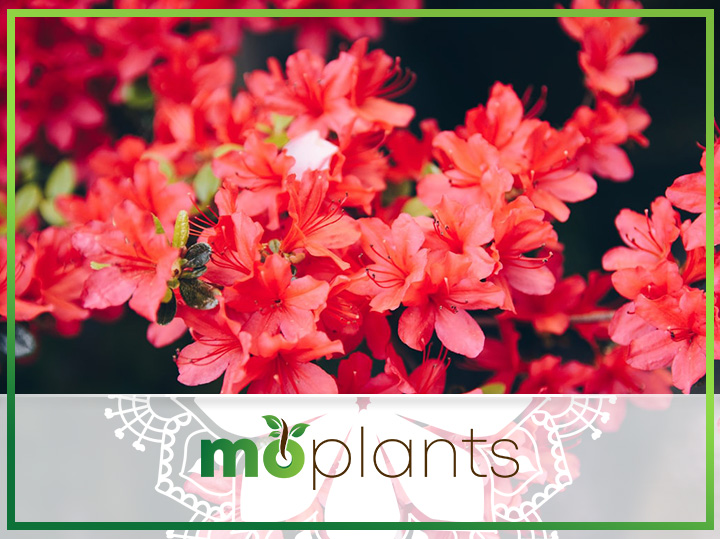The lush green foliage and breathtakingly beautiful blooms make rhododendrons one of the most spectacular flowering plants you can grow in your garden. These evergreen perennial shrubs produce a large cluster of a funnel or bell-shaped flowers in the spring, though their leaves remain vibrant throughout the year.
Since rhododendrons quickly grow into huge bushes with thick vegetation, they are not ideal for growing indoors in small containers or flowering beds. If you want to watch these enchanting beauties reach their full potential, consider planting them outdoors in the ground where they can grow freely.
There are thousands of rhododendron cultivars available in nurseries and garden centers in most parts of the country, which means you are spoiled for choices when it comes to selecting flowers for your garden. From large pink and purple blooms to clusters of reds and yellows, these enchanting blossoms will boost your curb appeal and make your landscaping skills the talk of the town.
Whether you are a seasoned pro with years of experience under your metaphorical belt or a beginner hoping to show off their gardening skills to the neighborhood, this handy guide will help you grow rhododendron flowers without any hassle.
Introduction: Rhododendrons
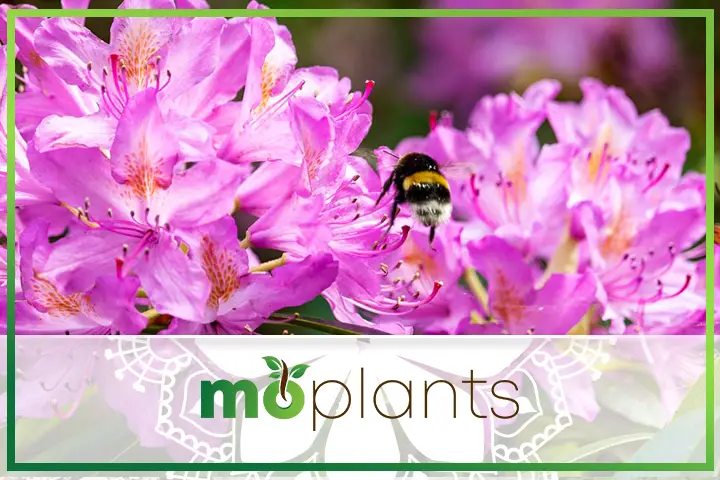
Rhododendron is a genus of over a thousand wild species of woody plants in the Ericaceae family. These bountiful shrubs grow in most parts of the United States, making them an ideal addition to any garden. The most popular types of rhododendrons are native to Asia, Europe, North America, and Australia, where they grow in abundance.
While there are more than 14,000 hybrid varieties of this plant, experts categorize rhododendron shrubs into two main categories: deciduous and evergreen. The colors of their flowers range from white and pale pink to deep red and violet, adding a burst of color to any landscape.
Most rhododendron flowers grow early in the year between April and July, though some may bloom a little later. It is also worth mentioning that some of these varieties grow as compact shrubs while others may grow as tall as 20 feet. Meanwhile, their width ranges from three to 25 feet.
Furthermore, these hardy plants are known for attracting bees to the garden. They are also rather low maintenance and grow successfully in most climates as long as you provide them with the right soil and plant them in the right location. However, some varieties may be a little more demanding than others. Therefore, make sure to find out which rhododendrons you have planted in your home so you can look after them accordingly.
Most types of rhododendrons flourish in USDA hardiness zones 4 to 8. They love the dappled shade and do not appreciate the full morning sun that most flowering plants require to bloom. Moreover, rhododendrons’ foliage, flowers, and nectar are highly toxic to cats, dogs, and livestock.
Rhododendrons vs. Azaleas
Often grown next to each other, rhododendrons and azaleas often get confused due to their similar appearances and almost identical growing conditions. Though the two plants were previously categorized as different species, they are now placed together in the same genus.
One of the main differences between rhododendrons and azaleas is their size. The former tends to have larger shrubs with wide leaves and relatively big flowers. In addition, rhododendrons grow well in cold climates and prefer weather that is not too hot or too cold. On the other hand, azaleas thrive in hotter and humid conditions. They are also not tolerant of frost.
How to Grow Rhododendrons

Let’s look at some tips on how to grow rhododendrons successfully.
Planting and Placement
Though you can transplant them throughout the growing season, the best time to plant a rhododendron bush is between March and April or September and December.
You can plant these shrubs in an area with spotted shade. However, refrain from choosing a site underneath large trees where they may not receive much sun. Additionally, it would be best if you considered planting rhododendrons nearly two to six feet apart to ensure they have enough room to grow and expand.
Exposure to Sunlight
As mentioned above, rhododendrons flourish in woodland with dappled shade. Prolonged exposure to the sun can burn their foliage, whereas too little light may result in fewer blossoms.
If you plan to grow rhododendrons, it would be best to choose a site that receives adequate morning sun or indirect sunlight throughout the day.
Watering Frequency
Rhododendrons have very shallow roots, which allows them to get plenty of oxygen but may also lead to stress if you don’t water them frequently.
Ideally, it would help if you watered a rhododendron bush at least twice a week during the growing season. Once the plant matures, make sure to touch the soil underneath the mulch at the top before watering it.
If the soil feels moist, your rhododendrons don’t need extra water. However, if the soil feels dry, make sure to water the plant thoroughly.
Potting Mix
These flowering plants thrive in acidic soil with a pH between 4.5 and 6.0. Those looking to grow rhododendrons should consider buying moist and well-drained soil. Since these shrubs have shallow roots, they won’t do well in clay-heavy soil or one with poor drainage.
Infographic
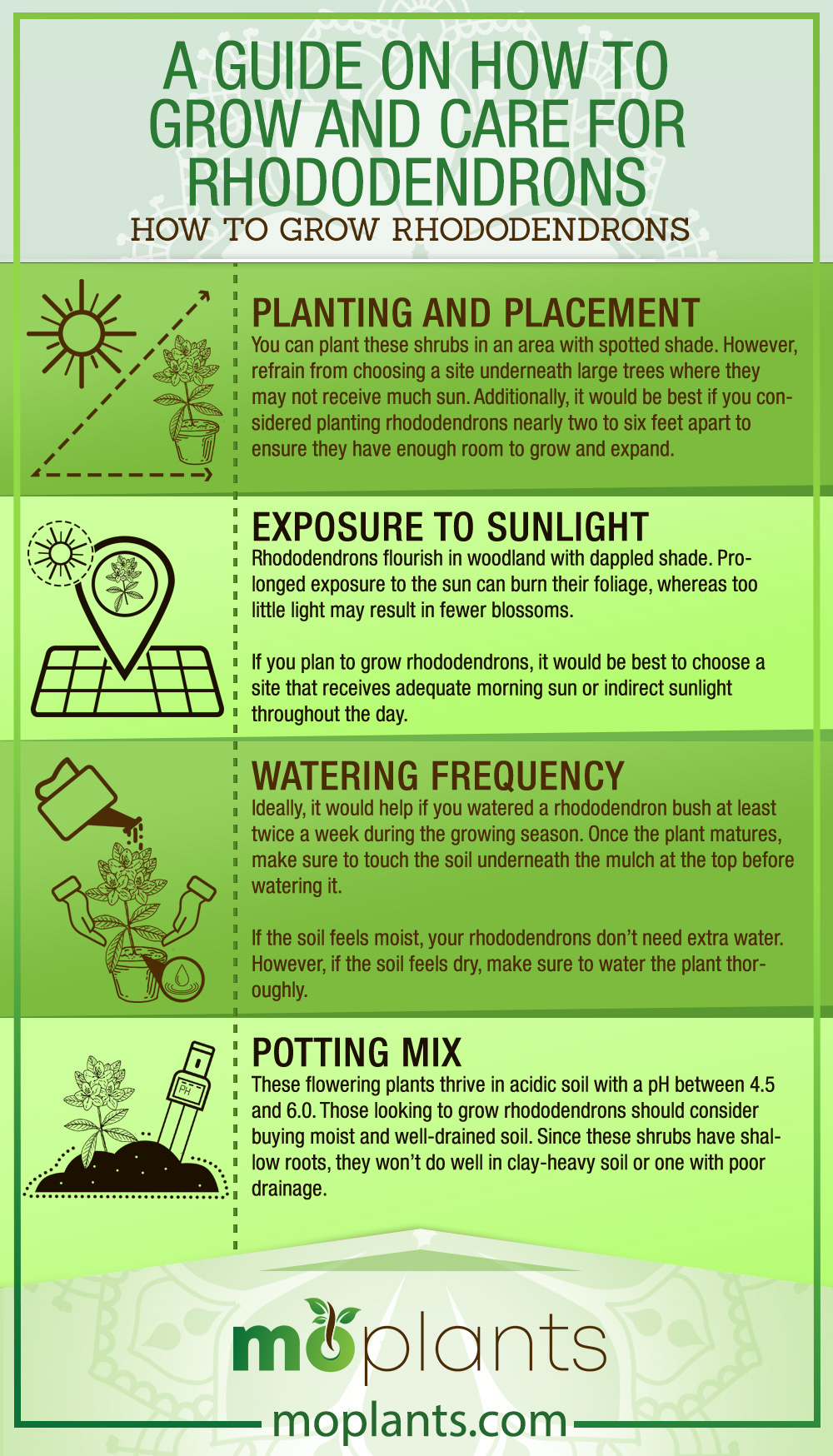
How to Grow Rhododendron Plants from Cuttings
Here is a step-by-step guide on how to grow rhododendron plants from cuttings.
Step 1: Select healthy plant branches with a terminal bud at the end. It would be best to choose a branch that is growing upright.
Step 2: Sanitize your pruning shears and cut the chosen branch at an angle to encourage new growth. Ideally, your cutting should be around three inches long. You can also take more than one cuttings to ensure successful propagation.
Step 3: Please remove all but four leaves from the top of your cutting before cutting inch-long slivers at the bottom for root growth.
Step 4: Sanitize the cutting and let it dry before dipping the cut end into a rooting hormone powder.
Step 5: Add potting medium to your chosen container and make a small hole in the middle to insert your cutting.
Step 6: Water the soil and cover the container with a clear plastic wrap to trap the moisture.
Step 7: Place the container in a location that receives bright but indirect sunlight. The temperature of the soil should ideally remain around 70 degrees Fahrenheit.
Step 8: It takes about two to three months for the cuttings to develop roots. Please make sure to remove cuttings that show signs of distress. Once roots begin to form, consider transplanting them to a larger pot or an outdoor location.
Rhododendron Care Tips
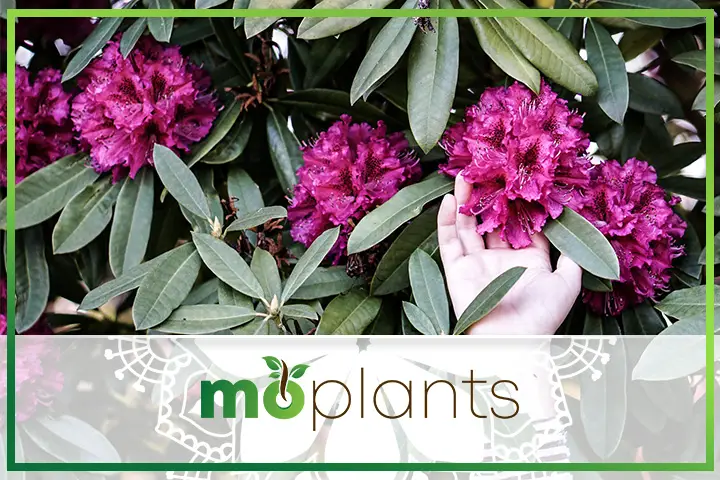
Now that you know how to grow these dazzling flowering shrubs in your garden let’s look at some rhododendron care tips that will prolong their life and keep them looking healthy at all times.
Temperature
Rhododendrons are both heat and cold tolerant, but they prefer to grow in temperatures between 60 and 70 degrees Fahrenheit.
During winters, most types of rhododendrons can survive temperatures as low as -35 degrees Fahrenheit. However, their leave may start to curl and droop at 32 degrees Fahrenheit.
Deadheading
Deadheading your rhododendrons will help them produce new flowers and stay fresh throughout the year. However, it is imperative to snip the faded blooms carefully as the new buds are just under the older, spent ones.
Pruning
It may not be the best idea to prune your rhododendron plants, as they are meant to grow and sprawl. Nevertheless, if you want to reduce their size or give them a more symmetrical appearance, consider pruning them right after they bloom. Otherwise, your rhododendron bush might not produce any flowers during the next season.
As for the dead branches, feel free to remove them as convenient for ultimate rhododendron care.
Fertilizing
Rhododendrons are not particularly heavy feeders. You can fertilize them occasionally during the growing season using a specialized mix.
Infographic
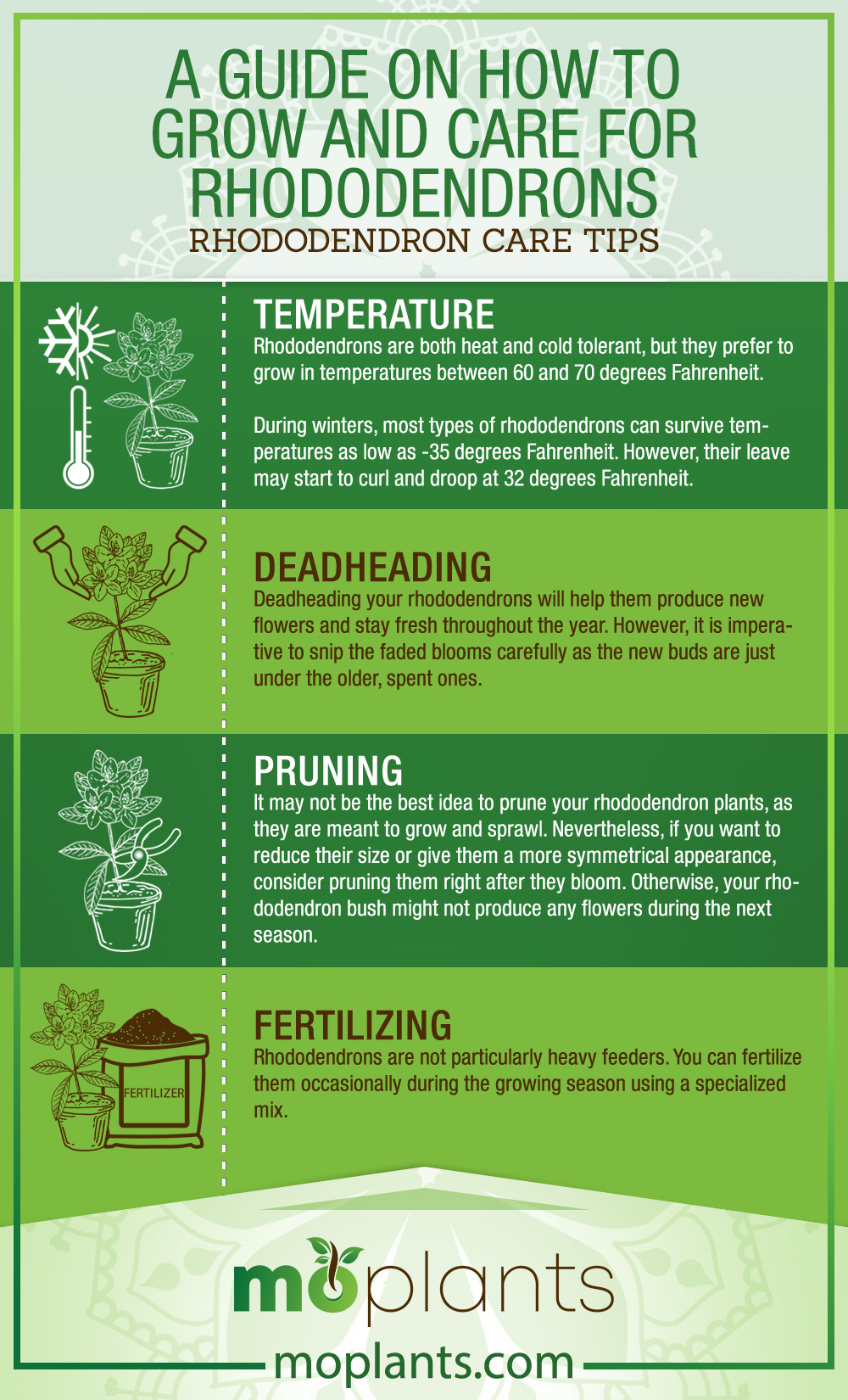
Common Rhododendrons Problems and How to Solve Them
These are some of the most common issues you may face while growing rhododendron plants, along with their respective solutions.
Pale or Yellowing Leaves
The most common reason rhododendron foliage begins to turn pale or yellow is the lack of soil acidity. If the soil is neutral or more alkaline, your plant will not get sufficient nutrients, resulting in discolored leaves.
The best way to troubleshoot this problem is to test your soil pH and add organic matter to adjust its level.
Lack of Flowers
If your rhododendron bush is not blooming prolifically, there could be several reasons behind it. The first culprit is usually alkaline soil, followed by a lack of sunlight. In addition, excessive pruning and frost damage to the buds can also diminish flower production.
To ensure your plant continues to bloom, make sure to adjust the pH level of your soil and water it regularly. Too much or too little fertilizer may also result in reduced flowers.
Common Pests and Diseases
Rhododendrons are prone to weevils, lace bugs, and powdery mildew, among other pests. If you notice any white growth on the leaves or notice brown and wilted foliage, it may be time to spray them with a light pesticide.
Popular Types of Rhododendrons
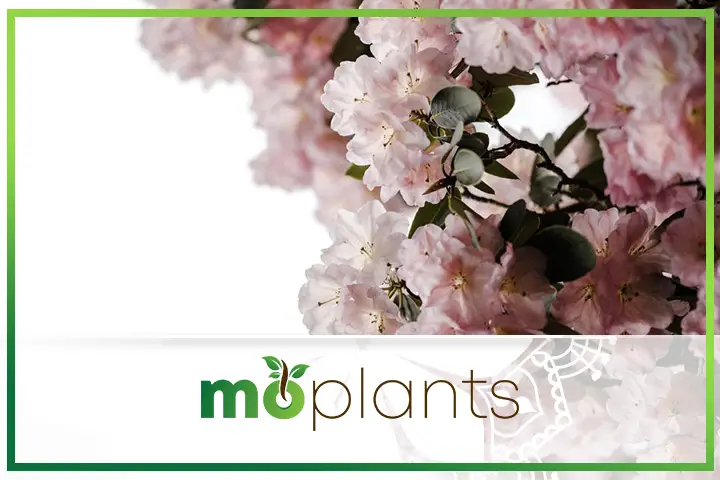
Let’s check out the most popular rhododendron varieties to brighten up your home.
Rhododendron Elviira
The cherry-red blooms and dark leaves of Rhododendron Elviira have added to their popularity as one of the most charming plants to grow. The broadleaf shrub is compact and coarse, producing trumpet-shaped flowers in the spring months. The foliage remains green throughout the year, whereas the blossoms feature a subtle fragrance.
Rhododendron Elviira usually grows up to two feet in height and width. Moreover, this shrub has a lifespan of 40 years.
Rhododendron Bow Bells
The bell-shaped flowers of Rhododendron Bow Bells are the main attraction of this evergreen shrub. The blooms are about seven centimeters long and grow in loose clusters, giving the plant a visually appealing look. Its foliage features oval-shaped leaves that are usually four to six centimeters long.
Moreover, this rhododendron variety grows vertically. However, it does so at a very slow pace.
Rhododendron Blue Peter
The violet-blue flowers of Rhododendron Blue Peter come in many shapes and sizes. Some grow in clusters with tubular or bell-shaped forms, while others may grow in solitary. The frilled patterns of these eye-catching blossoms are paired with large green leaves of the bushy shrub, which can grow as tall as 10 feet.
A unique thing about Rhododendron Blue Peter is that these plants can be either deciduous or evergreen.
Rhododendron Nova Zembla
Yet another evergreen shrub, Nova Zembla, is one of the most popular types of rhododendrons due to its vertical growth and striking red flowers. This fascinating plant features dark green foliage and large trumpet-shaped flowers that grow in solitary.
In perfect conditions, the shrub can grow up eight feet tall and seven feet wide, easily taking over your entire garden and turning it into a mesmerizing wonderland.
Rhododendrons FAQs
These are some of the most frequently asked questions about rhododendron care and growth.
Where is the best place to plant a rhododendron bush?
You can grow rhododendrons in very large containers or the ground, depending on the variety and mature size. As for the placement, these shrubs do well in dappled or partial shade. Hence you can plant them on the north side of your house.
What are some of the disadvantages of growing rhododendrons?
Its toxicity to animals and extremely thick vegetation are two of the biggest cons of growing rhododendrons.
How long do rhododendrons last?
Typically, the blooms can last anywhere between two and seven months.
What can you plant next to your rhododendrons?
Mountain Laurel and Japanese andromeda are both considered the best companions for the gorgeous rhododendrons.
To summarize, if you are looking for a relatively easy-to-grow flowering shrub that will produce show-stopping blooms in spring and display vibrant foliage during the rest of the year, rhododendrons are your safest bet. These cold-hardy and heat-tolerant plants will add a burst of color to any garden with their bright pink, yellow, red, orange, white, and purple flowers.
While some varieties of these fascinating beauties grow closer to the ground and expand in width, others can turn into trees with a height of 20 feet or more.

